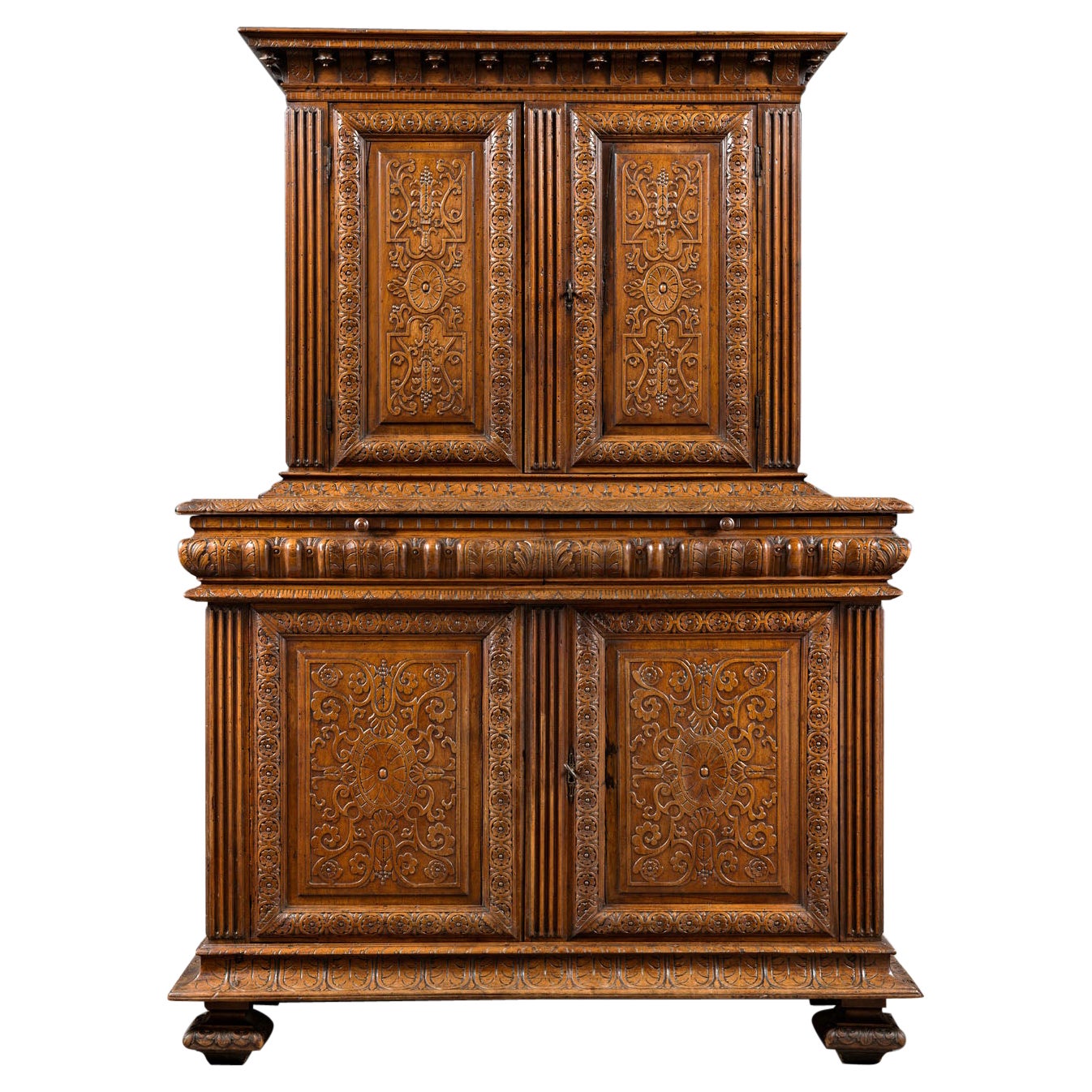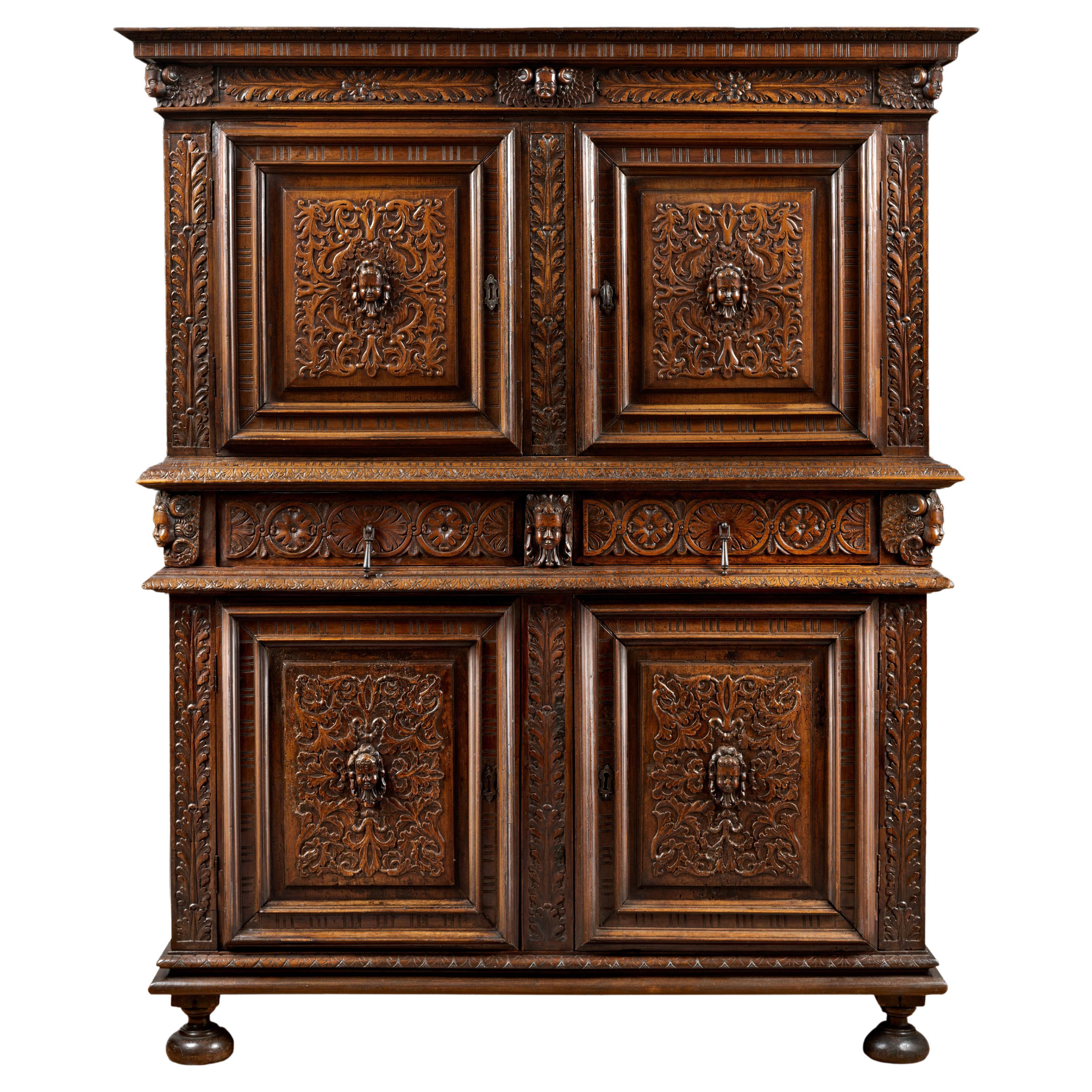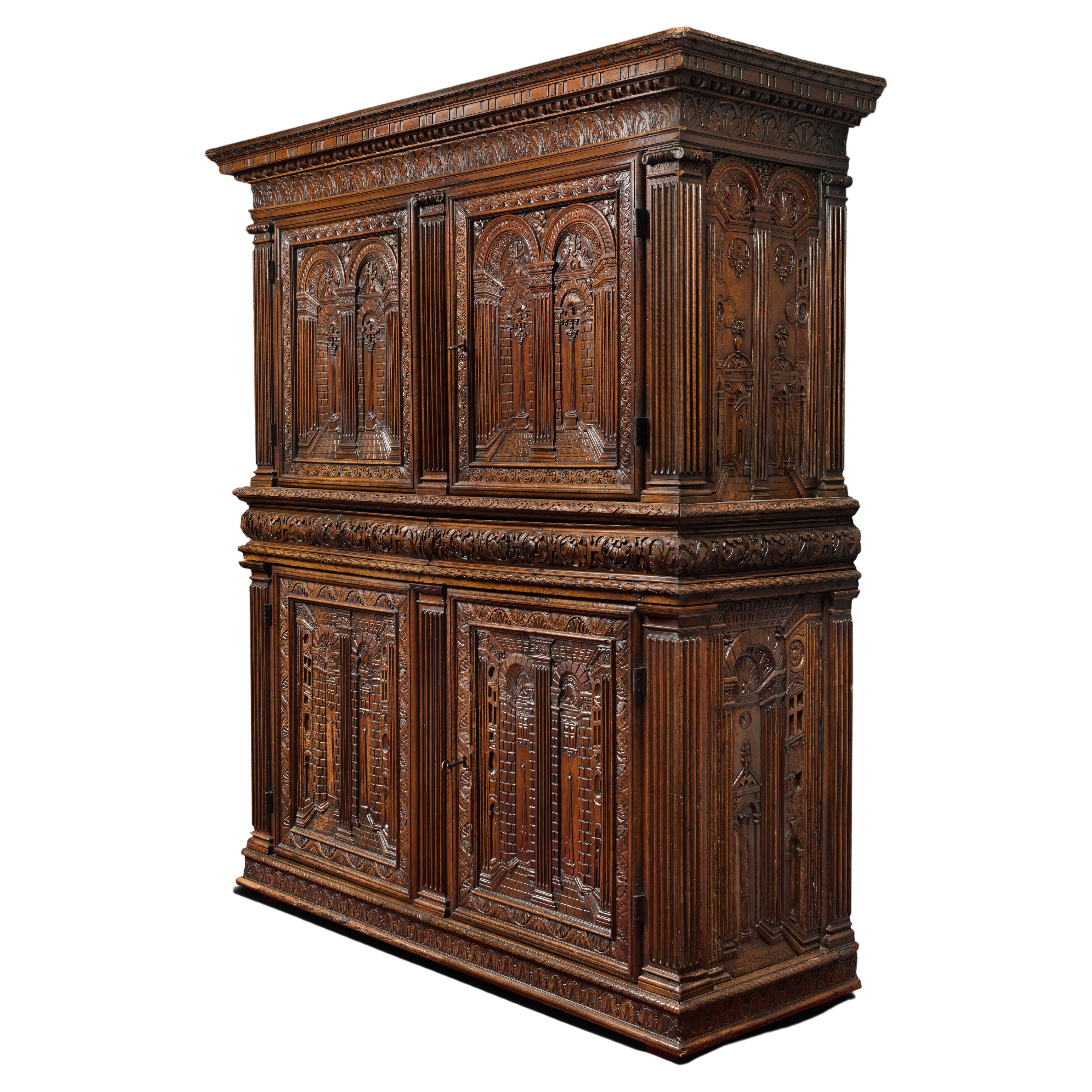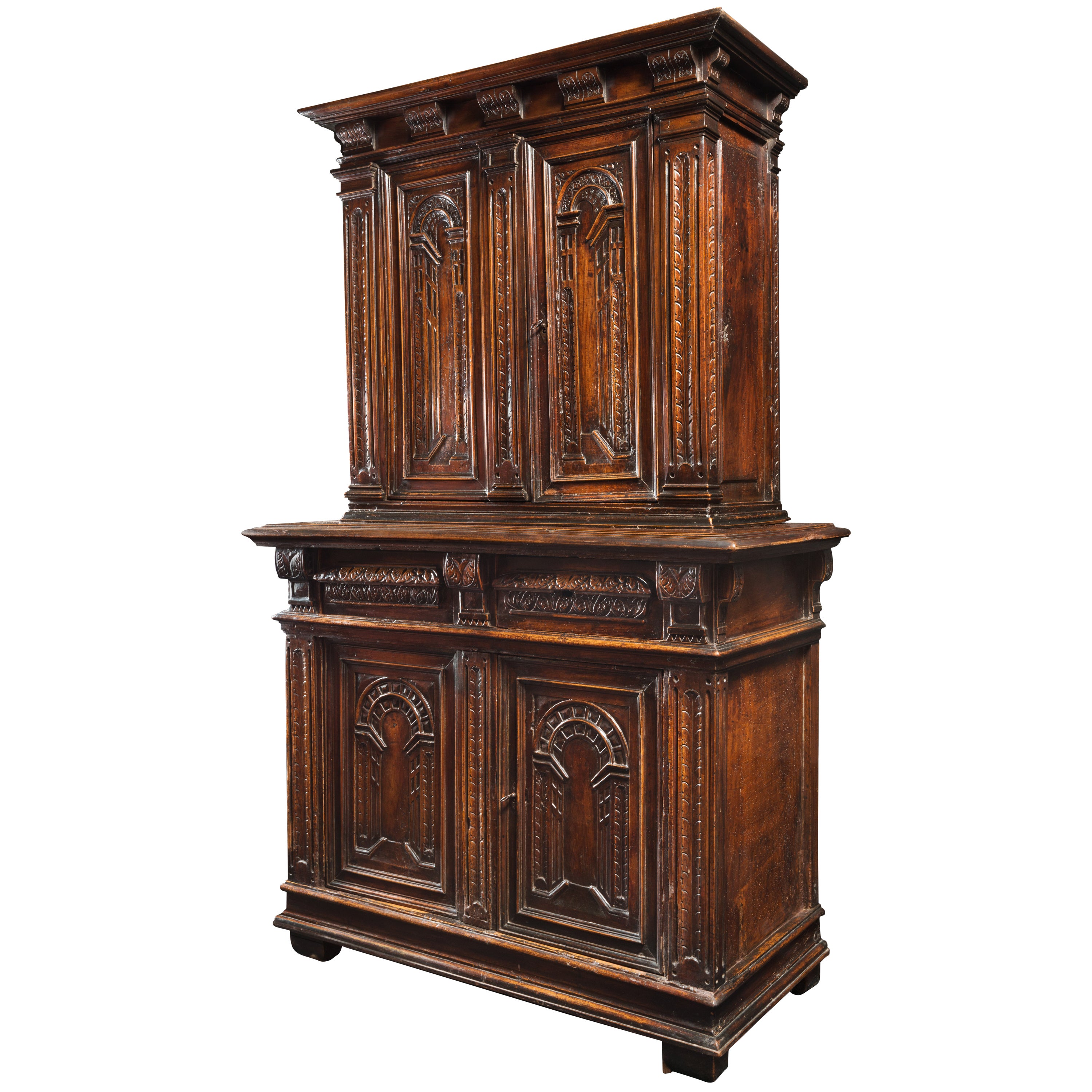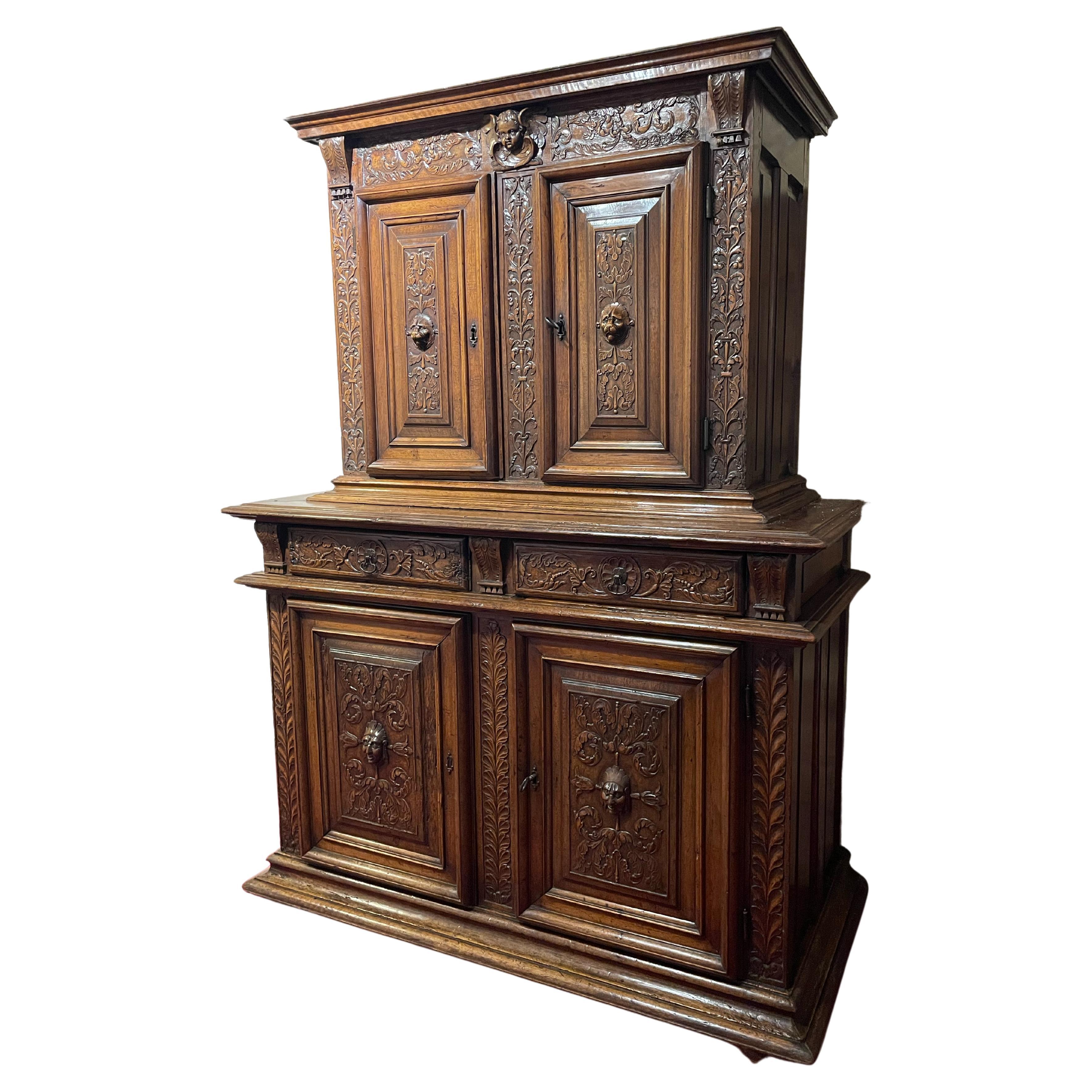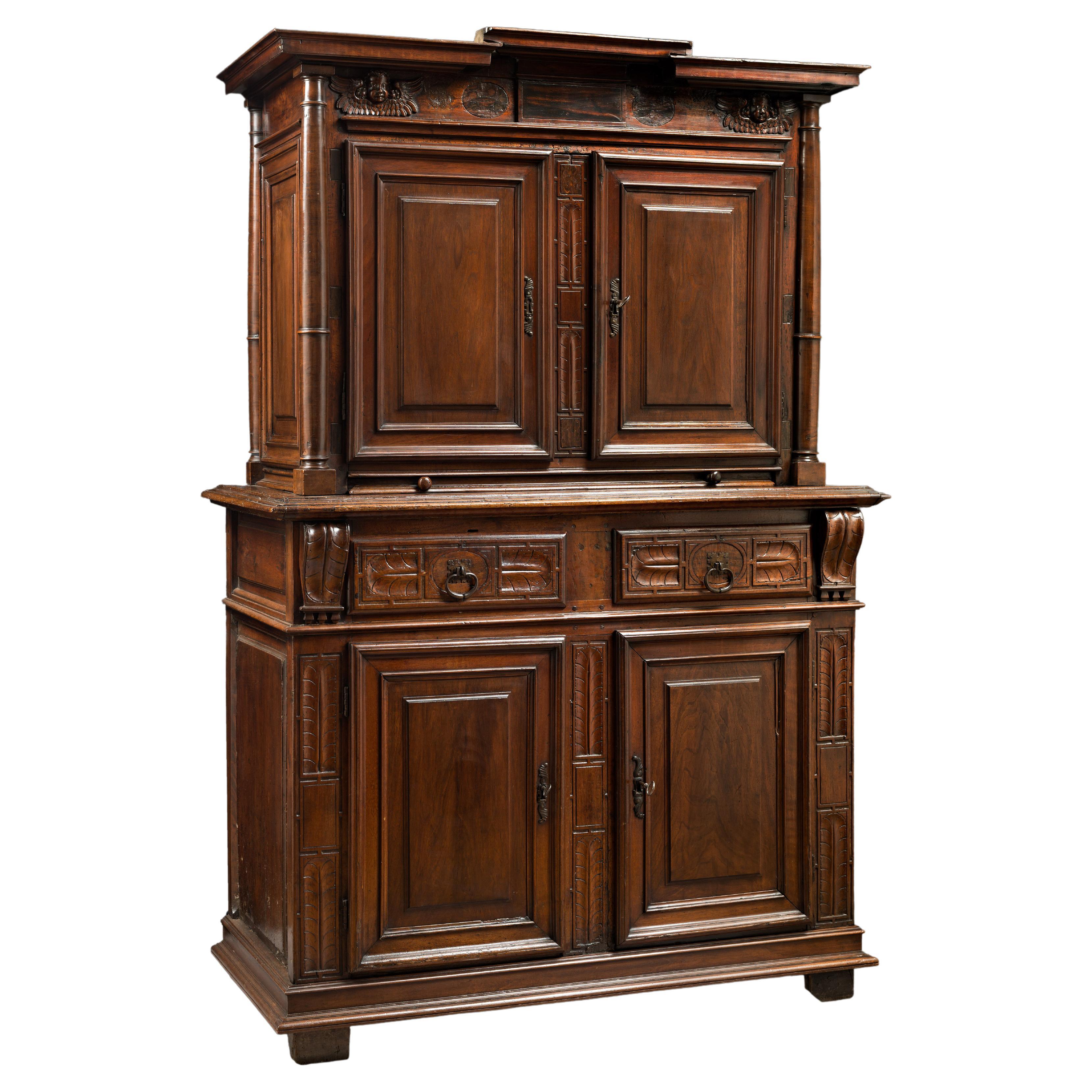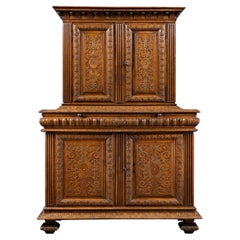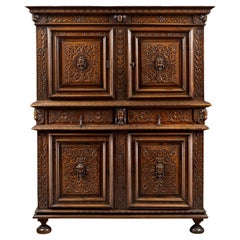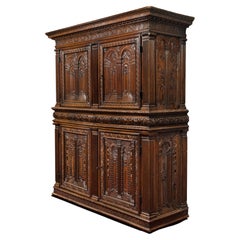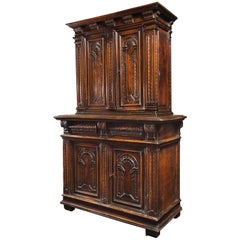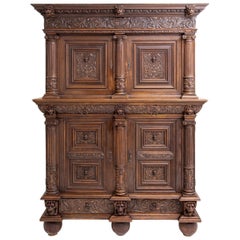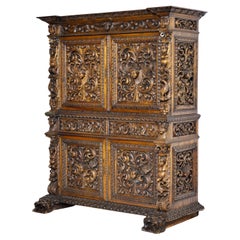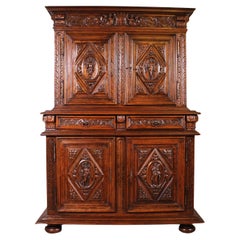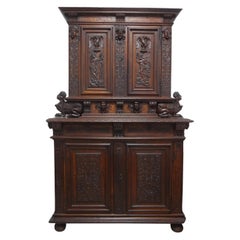Items Similar to Renaissance Cabinet form Lyon 'France'
Want more images or videos?
Request additional images or videos from the seller
1 of 6
Renaissance Cabinet form Lyon 'France'
$17,913.72
£13,246.64
€15,000
CA$24,606.23
A$27,360.72
CHF 14,323.83
MX$334,216.26
NOK 179,993.02
SEK 169,319.51
DKK 114,213.45
About the Item
Condition : Partly dating from the Renaissance. The backs and the drawer’s insides have been re-done.
Historical background
The 16th century is a prosperous period for Lyon. The several fairs held in the city assure an economic vitality as well as a position of European crossroad. The royal court and many talented artists sojourn in this city thus promoting artistic creation. The thriving Lyon printing industry broadcasts models from the most influent and innovative artists. Those models are absorbed, revisited, transformed by Lyon workshops.
This is also during the 16th century that the city of Lyon re-discover its glorious antic past. Classical Antiquity gives the city fresh air to breathe with a new ornamental repertoire, interlacings, laurel leaves, choux bourguignons, palm leaves, spokes of heart, putti and grotesques.
These motifs can be seen on cabinet-makers’ and wood-carvers’ production. Artisans uses ornamental techniques similar to engraving’s giving a true identity to Lyon’s furnishing.
Furthermore Lyon’s cabinet-makers renew the furnishing’s structure using Antic architectural vocabulary first updated by Italian artists. This classical language may have been boosted by Sebastiano Serlio’s presence in Lyon. Likewise, Philibert de l’Orme, architect born in Lyon, travels to Rome to get acquainted with classical architecture.
While these references to Antiquity are common to all of Europe, Lyon distinguishes itself by using Antic concepts of balance and structure and by not being to literal, dismissing columns and pediments. The final result is perfectly harmonious and appears less architectural than in other regions.
Description
This is a two bodies cabinet with a recessed upper body. It opens with four door-leaves and two drawers inside the belt. The cabinet stands on a moulded and leafy base. The cabinet’s perfectly mastered architectural design and the balance of proportions are remarkable.
The cabinet’s structure is cleverly broke down. Horizontally the two bodies are divided by the two drawers belt. Vertically the four door-leaves are framed by jambs enriched with palm-leaves, choux bourguignons, flowers and blackened wood cartouches.
The two lower-body door-leaves are inserted in a mitre-cut assembled moulded frame and are ornated with symmetrical interlacings and vegetal scrolls. From those curls appear stylized birds’ heads centred by a chou bourguignon.
Both drawers are adorned with fruit garlands. A console separates the drawers.
The upper-body door-leaves are carved with leafy interlacings centred by a female mask.
The side panels are carved with a radiating rose decor for the upper-body and leafy blackened wood for the lower-body. The jambs are enriched by laurel frieze and an interlacing decor adorns the belt.
The care given to the lateral panels’ decor testifies the refinement of this cabinet.
The cabinet is topped by a protruding cornice carved with two palm-leaves friezes highlighted by two fusarolles. Two winged putti’s heads consoles and one female mask console support the cornice.
This cabinet’s decor shows a remarkable quality of execution and an amazing diversity. Friezes, panels, masks are all individualized. The refinement of the ornaments is anything but dull with reliefs producing light and shadow effects animating the panels’ surface. No doubt this sumptuous cabinet has been delivered by a skilled artisan.
With this perfectly harmonious cabinet are united an architectural structure and an engraving-style inspired decor. Those elements are typical of the school of Lyon between 1540 and 1570.
Literature
BOCCADOR Jacqueline, Le Mobilier français du Moyen Age à la Renaissance, Éditions d’art Monelle Hayot, 1988
THIRION Jacques, Le Mobilier du Moyen Age et de la Renaissance en France, Edition Faton, 1998
VIRASSAMYNAÏKEN Ludmila (dir.), Arts et Humanisme, Lyon Renaissance, Somogy éditions d’arts, Paris, 2015.
- Dimensions:Height: 82.68 in (210 cm)Width: 59.85 in (152 cm)Depth: 20.87 in (53 cm)
- Style:Renaissance (Of the Period)
- Materials and Techniques:
- Place of Origin:
- Period:
- Date of Manufacture:Second Half of the 16th Century
- Condition:Replacements made: Partly dating from the Renaissance. The backs and the drawer’s insides have been re-done.
- Seller Location:Saint-Ouen, FR
- Reference Number:1stDibs: LU3115327198182
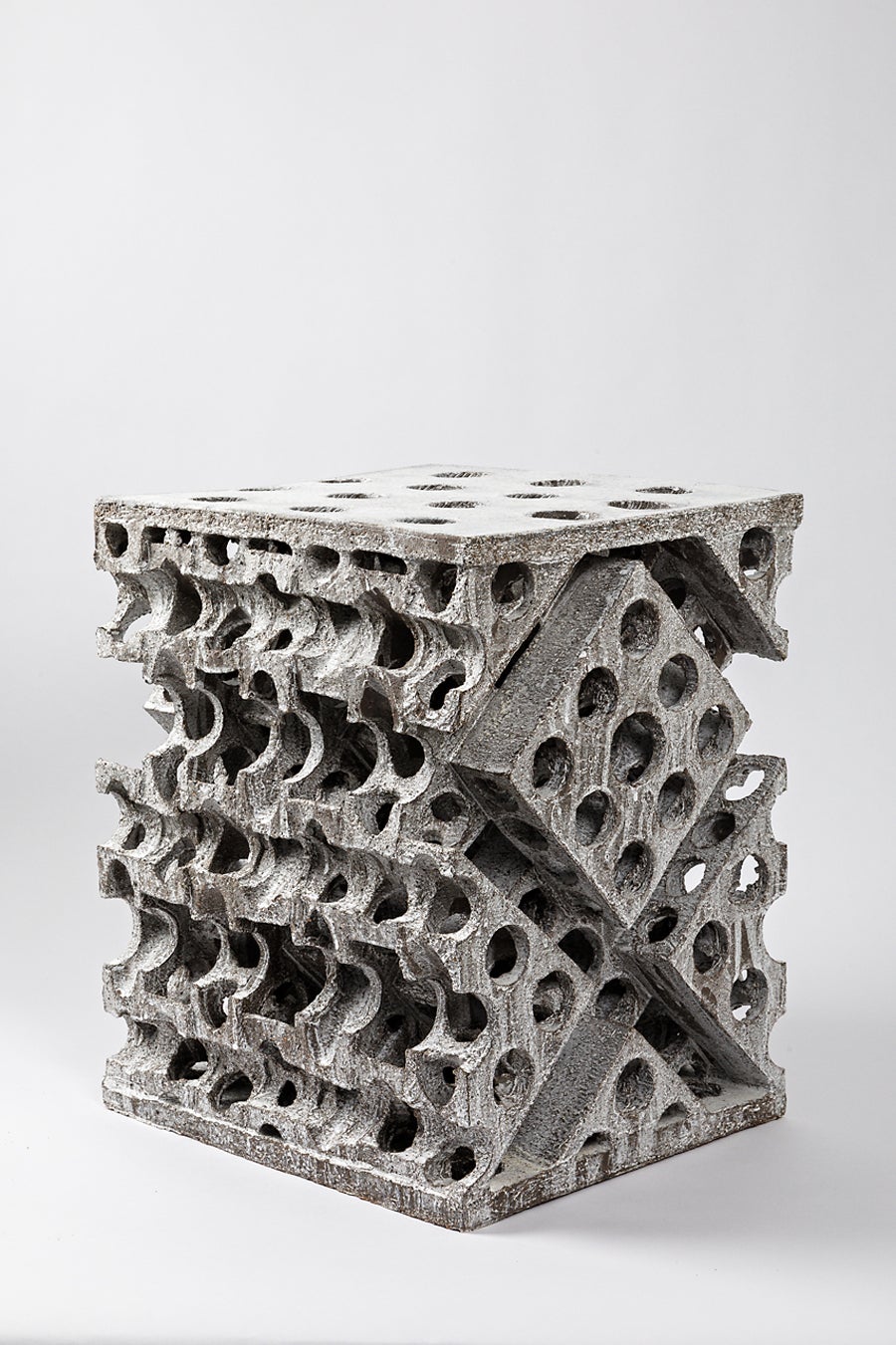
About the Seller
5.0
Vetted Professional Seller
Every seller passes strict standards for authenticity and reliability
Established in 2016
1stDibs seller since 2017
193 sales on 1stDibs
Typical response time: 2 hours
- ShippingRetrieving quote...Shipping from: Saint-Ouen, France
- Return Policy
Authenticity Guarantee
In the unlikely event there’s an issue with an item’s authenticity, contact us within 1 year for a full refund. DetailsMoney-Back Guarantee
If your item is not as described, is damaged in transit, or does not arrive, contact us within 7 days for a full refund. Details24-Hour Cancellation
You have a 24-hour grace period in which to reconsider your purchase, with no questions asked.Vetted Professional Sellers
Our world-class sellers must adhere to strict standards for service and quality, maintaining the integrity of our listings.Price-Match Guarantee
If you find that a seller listed the same item for a lower price elsewhere, we’ll match it.Trusted Global Delivery
Our best-in-class carrier network provides specialized shipping options worldwide, including custom delivery.More From This Seller
View AllExceptional Renaissance Cabinet from Lyon
Located in Saint-Ouen, FR
Exceptional Renaissance Cabinet from Lyon
Origin: Lyon, France
Period: 1540-1580, Second French Renaissance
Measures: Height: 188 cm
Length: 132 cm
...
Category
Antique 16th Century Cabinets
Materials
Walnut
Small Renaissance Cabinet from Lyon
Located in Saint-Ouen, FR
Small renaissance cabinet from Lyon.
ORIGIN: FRANCE, SCHOOL OF LYON
PERIOD: 16th CENTURY
Height:151cm
Depth: 120cm
Length: 54cm
Walnut ...
Category
Antique 16th Century Cabinets
Materials
Walnut
Important Renaissance Cabinet from Lyon 'France' with a Decor of Perspectives
Located in Saint-Ouen, FR
As soon as 1540 France's second Renaissance is in the making, intimately linked to the rediscovery of the Antique world. The development of the printing and engraving industry allows the spread of artworks and models in many cities and countries. The Italian influence can be perceived in every artistic field. While the French king entrust the most talented Italian artists with major projects such as Il Rosso or Primaticcio in Fontainebleau, French artists also travel to Italy to form themselves to this new style. In Italy they get acquainted with the work of Leo Battista Alberti the first to theorize perspective (De Pictura, 1435-36) and architecture (De re oedificatoria, 1541). Those two publications would have a revolutionary impact on arts.
Furniture is marked by the work of the most famous Italian architects of the time as well as French architects. Indeed Philibert de l'Orme competes with Alberti and by the end of his life publishes several treaties including one devoted to a theory of architecture (1567). Unfortunately he would not live to complete the second volume. In this treaty he expresses his interest for mathematical norms applied to architecture, copied from the Antique. His journeys in Italy allowed him to accumulate the most sophisticated references. Jean Bullant, another architect of great talent also theorizes his practice. He establishes rules characterizing Greco-Roman art staying faithful to Vitruvius.
Following this new inspiration the structure of furniture evolves. From then on appear columns, capitals, cornices, friezes and architraves. The ornamentation uses this inspiration as well with egg-and-dart, palm leaf and rose adorning the most beautiful pieces.
In Lyon, crossroad where meet merchants from everywhere those new experiments are welcomed. Lyon florishing printing industry allows the spreading of models and treaties essential to the artist's work. Thus the first publication of Vitruvius' De Architectura in France would be printed in Lyon in 1532.
Artists from Lyon rediscover and familiarize themselves with the Antique knowledge very early. They adopt those new ideas and use them in their own creations. Lyon cabinet-makers re interpret Antique architecture and Italian Renaissance palaces to give their pieces a pure and harmonious architectural structure. Grooved pilasters are particularly favored. They are topped by capitals of diverse orders always respecting the sequencing with simpler ones for the lower levels and the richest ones on the higher levels. As for the ornamentation, one of the great distinctiveness of Lyon workshops remains the architectural perspective illusions, drawing inspiration from Tuscany.
True masterpiece of the Second French Renaissance this important cabinet illustrates Lyon workshops' taste for fine Italian architecture inspired by Antiquity. An architectural perspective of great quality is treated in symmetry on each panel.
This two-bodied cabinet without recess stands on four rectangular feet. The base comprises a molding, a palm leaf frieze and is bordered by a braid.
The lower body is divided by three grooved pilasters with Tuscan capitals framing two door-leaves. The two panels are encircled by a moudled frame with palm leaves. They are finely carved with a decor of fantasized architecture depicting an Italian Renaissance palace erected symmetrically on each side of a grooved pilaster. On the ground floor a door opens through a stilted arch while the stories are opened with mullioned windows, dormers and occuli. Two large pegged-boss cladded pillars support the entablature enriched by a palm leaf frieze upon which stands an arch whose coffered intrados is centred by a rose. Behind this arch a pyramid appears, standing in front of a second facade with a window topped by a broken curvilinear pediment under a cul-de-four with a shell.
The checker flooring gives depth to the low-reliefs creating vanishing points structuring the panels and guiding the eye of the observer.
A thin laurel braid highlights the belt of the cabinet where are located two drawers. Their facades are adorned by palm leaves in hoops.
The upper body is encircled with palm leaves. The same ternary division as in the lower body appears. However, the pilasters are topped by Ionic capitals with volutes and egg-and-dart. The door-leaves are framed with flowers. On the panels the artist has designed another architectural decor. On the foreground open two arches on top of grooved pilasters with rectangular capitals adorned with palm leaves. The arches are enriched with braids and the coffered intrados bears a decor of roses. The spandrels also bear a flower decor. In the background another arcature hosts a fluted grooved column topped with double basket acanthus capital, characteristic of Corinthian order. The triangular pediment is interrupted by a choux bourguignon.
A large cornice crowns the cabinet. It stands on pilasters and forms an entablature comprising a palm leaf frieze and an egg-and-dart, triglyph and palm leaf cornice.
The cabinet's sides have also been carefully considered. The lower body's panels are enriched with an arch rising above a broken pediment portico hosting a twisted column. Flowers garnish the spandrels. An architectural facade completes the decor. The upper body's panels present two arches supported by a facade opened with dormers and mullioned windows as well as cartouches (one bears the inscription 1580 dating the cabinet) suggesting the interior of an Italian Renaissance palace, confirmed by the chandeliers. The flooring leads our gaze to a second arch with a broken curvilinear pediment where stands a flower vase. This arch opens onto a perspective of another facade along a road.
Inside the cabinet, on the lower body door-leaves appear two designs. On the right door is depicted a Crucifixion. Saint Mary and Saint John flank the Christ on the cross. In the bottom part is inscribed « Dure uiator abis nihil haec spectacula curas / Pendenti cum sis unica cura Deo. / Tota suo moriente dolet natura Magistro. / Nil qui solus eras caussa dolenda doles. ». The signature [Christoff Swartz Monachiensis pinx[it] / Ioa[nnes] Sadeler sculp[it]] tells us it was made by Johan Sadeler I (1550-1600) after Christoph Schwartz (1548-1592). This engraving belongs to an ensemble depicting the Passion of Christ Johan Sadeler executed in 1589 after an altar piece painted by Christoph Schwartz for the private chapel of Renée of Loraine, wife of Duke William V of Bavaria. This altar piece made of nine copper panels has been destroyed during the 19th century. The Crucifixion panel once in the centre of the altar piece is the only one that survived and is today kept in Munich's Alte Pinakothek.
On the left door appears Saint Francis receiving the stigmata. The inscription says : « Signastidomine Servum Tuum. Franciscum. Signis Redemptionis Nostrae ».
This Renaissance cabinet with an architectural decor appearing as much in the structure faithful to Antique rules...
Category
Antique 16th Century European Renaissance Cabinets
Materials
Walnut
French Renaissance Cabinet with Perspectives
Located in Saint-Ouen, FR
This Renaissance Cabinet reveals the great mastery of the Lyon workshops which are at the origin of its realization. Sculptors and wood-carvers worked here in symbiosis to express an...
Category
Antique 16th Century French Renaissance Cabinets
Materials
Walnut
Small Renaissance Cabinet
Located in Saint-Ouen, FR
Small renaissance cabinet
ORIGIN : FRANCE
PERIOD : END OF THE 16th CENTURY
Measures: height: 167 cm
length: 123 cm
depth: 58 cm
This small two-part unit with harmonious proportions opens with four front leaves and two belt drawers. It rests on a molded base.
The uprights and the central frame of the lower body are adorned with long stylized palmettes. They frame the four leaves on which unfolds a vegetal decoration made of stems and leaves sculpted in symmetry around two mascarons topped with feathers...
Category
Antique 16th Century French Renaissance Cabinets
Materials
Walnut
$17,913
16th Century Renaissance Two-Bodied Cabinet
Located in Saint-Ouen, FR
Former collection Altounian
At the beginning of the reign of Henri II (1547-1559) the furniture’s ornamentation evolves. The few medieval motifs that were still used are eventually relinquished. Furniture becomes more sober showcasing moulded panels and perfect architecture. Cabinet-makers use ornaments such as curved fluted or plain columns, feather quills, roses or winged putti heads. High-relief carving becomes more scarce and compositions lighter. To that end cabinet-makers draw inspiration from Fontainebleau motifs filtering them and adapting them to French taste.
During this period cabinet-makers turn into a kind of architects. Indeed the architectural balance of furniture is the centre of their concerns. The study of Antic formulas is then a necessity. From this care given to proportions appear refined cabinets with pure lines.
This style is characteristic of the reign of Henri II and disappears soon after under the regency of Catherine de Medici (1560-1574) when an abundance of high and low-relief ornaments comes back on furnitures.
This two-bodies cabinet...
Category
Antique 16th Century French Renaissance Cabinets
Materials
Walnut
You May Also Like
Neo-Renaissance Cabinet, Late 19th Century
Located in Greding, DE
A four-door cabinet in Renaissance style standing on ball feet with lion's head mascarons and half-columns with volute capitals. The doors with panels and vine decoration are separat...
Category
Antique 19th Century German Renaissance Revival Cabinets
Materials
Wood
RENAISSANCE TWO BODY CABINET 19th Century
Located in Madrid, ES
RENAISSANCE TWO BODY CABINET 19th Century
In oak wood
Upper part with two profusely carved doors.
Lower part with two drawers and two doors.
Decorated with plant motifs, zoomorphic ...
Category
Antique 19th Century Portuguese Baroque Cabinets
Materials
Wood
$8,885 Sale Price
20% Off
Renaissance Buffet Representing The 4 Seasons Circa 1580 - France
Located in Brussels, Brussels
Superb and rare Renaissance period walnut buffet from the end of the 16th century representing the four seasons opening with four doors and two drawers on the front,
The doors offer...
Category
Antique 16th Century French Renaissance Buffets
Materials
Walnut
18th Century French Baroque Cabinet Or Deux Corps
Located in Houston, TX
18th Century French Baroque Cabinet Or Deux Corps
This handsome antique French Baroque cabinet has plenty of storage. with two door above three...
Category
Antique 18th Century French Baroque Cabinets
Materials
Walnut
Important 16th Century Renaissance Florentine Drop Front Desk Cabinet
Located in Dallas, TX
An Italian Florentine Renaissance Carved Burl Walnut Fall-Front Writing Cabinet, Circa 1560, 16th century
From the Davanzatti Palace Museum in Florence
Height: 59 inches x 36 inches ...
Category
Antique 16th Century Italian Renaissance Cabinets
Materials
Iron
18th Century Dutch Renaissance Cabinet
Located in Casteren, NL
Dutch Renaissance cabinet with two doors and one drawer.
Made from solid oakwood with mahogany veneer.
This cabinet has a rare and authentic ...
Category
Antique Early 18th Century Dutch Cabinets
Materials
Oak
More Ways To Browse
Antique Renaissance Furniture
French Renaissance Furniture
French Artist Model
French Renaissance Style
Recessed Cabinet
Renaissance Style Frame
Ornate Cabinet
Antique French Carved Wood Cabinet
Antique French Heart
Used School Cabinets
Antique Renaissance Cabinets
Form And Surfaces Doors
Used New Age Cabinets
Cabinet With Birds
Lyon Antique
Carved Cabinet Renaissance
Cabinet With Pediment
Renaissance Paris
